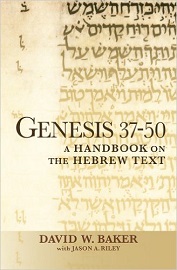 This book is in a series from Baylor University Press— Baylor Handbook on the Hebrew Bible. Their aim: “Rather than devote space to the type of theological and exegetical comments found in most commentaries, this series instead focuses on the Hebrew text and its related issues, syntactic and otherwise. The volumes in the series serve as prequels to commentary proper, providing guides to understanding the linguistic characteristics of the texts from which the messages of the texts may then be derived.”
This book is in a series from Baylor University Press— Baylor Handbook on the Hebrew Bible. Their aim: “Rather than devote space to the type of theological and exegetical comments found in most commentaries, this series instead focuses on the Hebrew text and its related issues, syntactic and otherwise. The volumes in the series serve as prequels to commentary proper, providing guides to understanding the linguistic characteristics of the texts from which the messages of the texts may then be derived.”
Let’s check what that means, practically. Would you like to know what the difficult word Shiloh means in Genesis 49:10? Baker and Riley have a short, helpful paragraph (438). They come to the same decision as the NIV: “to whom it belongs.” But you could find most of the same information they provide for free online.
Would you like further detail about Shiloh? You might turn to a recent commentary like that by Kenneth Mathews. He offers much more detail— four pages (volume 2, pages 893–896), rather than a brief paragraph.
Where Baker and Riley aim to shine, compared to a scholarly commentary, is in these areas:
1) Translation. The authors offer an insightful translation of Genesis 37–50, in small chunks. Comments and analysis follow each section.
2) Morphological analysis, especially with verbs. Most readers of this review can use programs like Accordance, BibleWorks or Logos to do the same thing, though there are a few passable sources online. Do you need someone to tell you that יִהְיֶה is a 3rd singular masculine Qal imperfect from הָיָה, meaning “he will be”?
Another concern is mistakes. Thomas Nass of Martin Luther College caught three in a quick spot-check of the book’s notes just on one chapter:
On page 54, וַתֹּ֤סֶף (Genesis 38:5) is not Qal, but Hiphil.
On page 69, וַתָּ֥סַר (Genesis 38:19) is not Qal, but Hiphil.
On page 74, נִהְיֶ֣ה (Genesis 38:23) is not singular, but plural.
3) Syntactical analysis. Baker and Riley cite syntax explanations from Paul Joüon and Takamitsu Muraoka’s A Grammar of Biblical Hebrew, Bruce Waltke and Michael O’Conner’s An Introduction to Biblical Hebrew Syntax and Ronald William’s Hebrew Syntax over 400 times.
But take the first two citations in the book: Do you need a reference to a paragraph in Joüon-Muraoka to know that the phrase “the sons of Bilhah” has a “genitive of kinship” (13)? Or that the phrase “in the midst of the field” features a “genitive of place” (18)?
Your reviewer does not mean to say that he made no syntax notes as he used the book to prepare for an in-depth class at Martin Luther College on Genesis 37–50. He found gems, but hardly on every page (or even every fifth page).
4) Discourse analysis. This is an area in which Baker and Riley shine, and which the average pastor reading this review will benefit— sometimes just with terminology, though your reviewer learned more in this area from the Ruth volume in the same Baylor series.
An instance of discourse terminology: The alert reader will notice in Genesis 37:2 that the Hebrew reads, “These [are] the family records of Jacob. Joseph, son of 17 year […].” The second sentence does not start with a verb. Topicalization, linguists call such arrangements, when Moses puts a noun like “Joseph” up front to set a scene, or for emphasis. (Note the topicalization of “topicalization” in the previous sentence.)
The book features a helpful glossary of such terms on pages 487–491, and an equally helpful index on pages 504–512, so that someone researching topicalization in Genesis 37–50 could quickly find the 138 instances of it in those chapters.
You could learn much from Baker and Riley about discourse features such as amplifying, embedding, mitigating, scene-setting and the like. Pages 3–8 would help you better understand the differences between narrative discourse, predictive discourse, expository discourse, hortatory discourse, interrogatory discourse, lists and poetry.
Should you buy this book? If your Hebrew is very rusty, you will probably skip this book. It does not have enough proverbial “bang-for-the buck,” it assumes a fairly strong knowledge of biblical Hebrew and its terminology, and it uses some terms you would have to get used to (such as qatal instead of “perfect,” or wayyiqtol, rather than “vav-consecutive imperfect”).
On the other hand, this book might be a good introduction to biblical discourse analysis beyond simple sentence structure. A few rusty or beginning readers may appreciate the exhaustive analysis of individual words, too. Your reviewer does not need a book to know that in Genesis 37:21 “Reuben” is a proper noun, the subject of the sentence (34). A few readers might like such help.
Typical pastors preparing sermons, Bible classes and researching matters of interest will be better off with a highly-rated commentary on the Hebrew text of Genesis. Concordia Commentary volumes (for Genesis, none have appeared) do not offer as many grammatical, syntactical and discourse notes as books in this series, but CC volumes combine some analysis in those areas with helpful commentary and application, so for most pastors in our circles they will be more useful.
David W. Baker has taught Old Testament and Semitic Languages at Ashland Theological Seminary in Ashland, Ohio since 1986. Prior to that, he taught at the University of Durban-Westville and the University of the Witwatersrand, both in South Africa, and Bethel College in St Paul, Minnesota. Baker has written or edited over 40 publications.
Co-author Jason Riley is a Ph.D. candidate at Fuller Theological Seminary.

